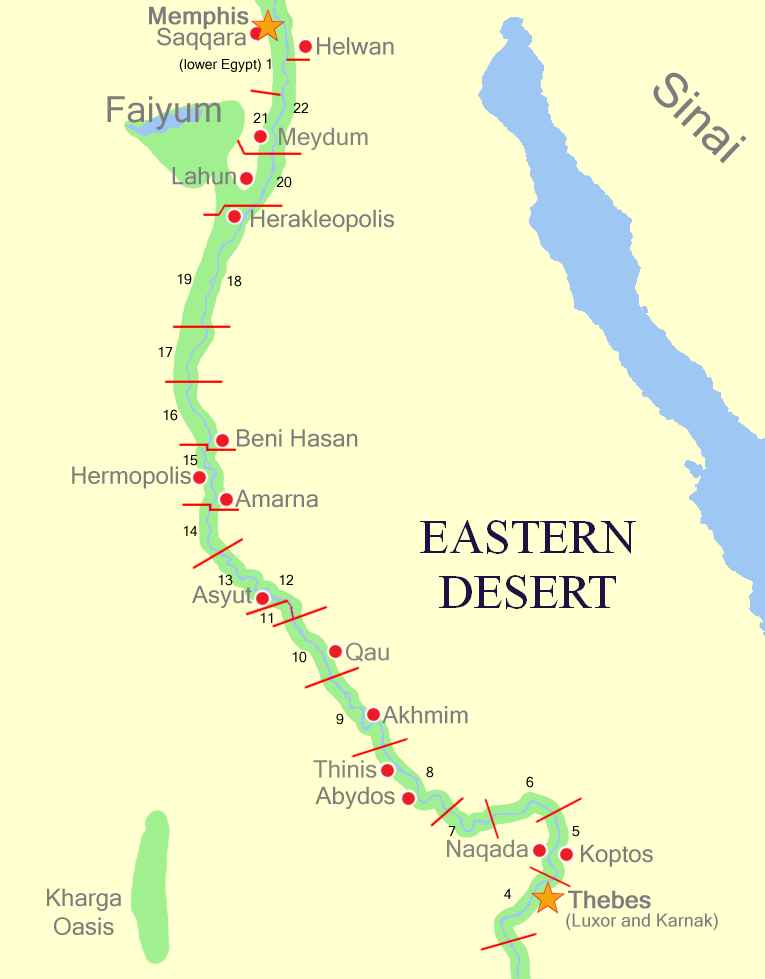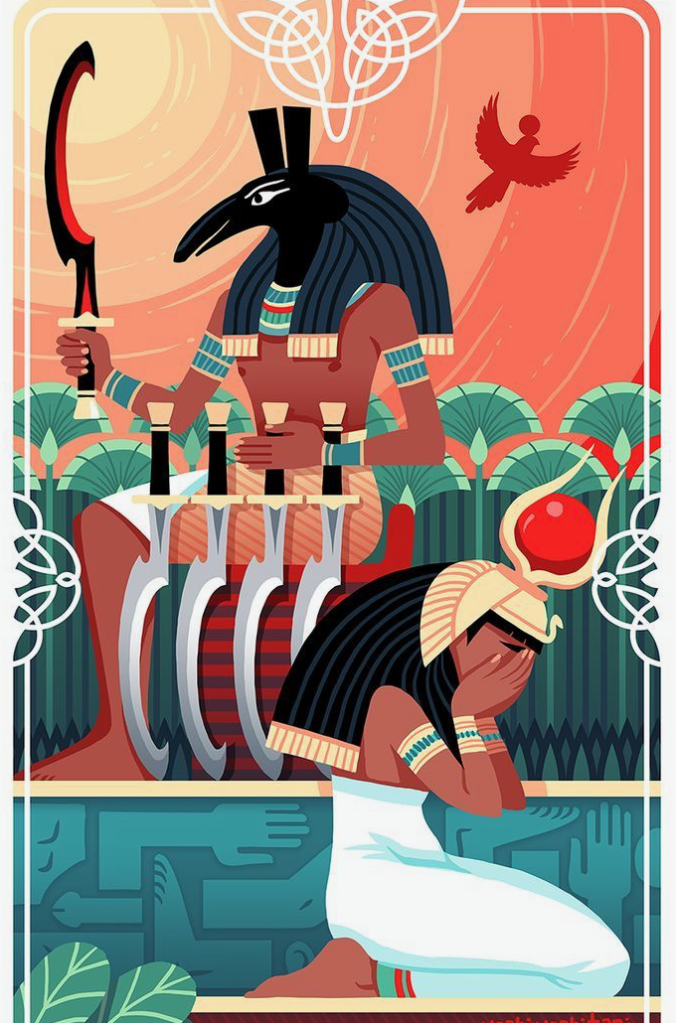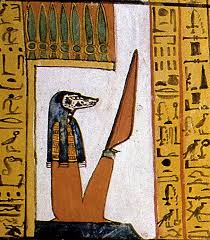Starting in the late-Ptolemaic period, we begin to hear of a Goddess called Neotera or Thea Neotera, the “Younger One” or the “Younger Goddess.” She’s a bit enigmatic because researchers aren’t sure exactly Who (or even who) She (or she) is.
Egyptologists have made a number of suggestions as to Her identity. Some identify Her as a Goddess, while others say she is a deified queen. (Hence my earlier capitalization ambiguity.)
Let’s look at the deified queen part first. Because that deified queen was most likely to have been Kleopatra VII; yes, THAT Kleopatra, the last of the Ptolemies, last ruler of an independent Egypt.
The Ptolemaic queens were into identification with Goddesses, Isis and Aphrodite being their top picks. Kleopatra, as mother of baby pharaoh Ceasarion, claimed for herself the title Nea Isis, “the New Isis.” What’s more, there actually were coins of the time bearing her image and the title of Thea Neotera. These were made by Kleopatra and Marcus Antonius for places outside of Egypt and meant to bolster her image in the greater world.
In Egypt, as you know, it was not unusual for there to be funerary cult maintained for rulers after their death and so we learn of a “great Kleopatreion” surviving at Rosetta (40 miles east of Alexandria, where the Rosetta Stone was found) into the 4th or 5th century CE. Alexandria was particularly resistant to Roman rule and it seems likely that, as Egypt’s last ruler, Kleopatra would have become popular with the people and her cult kept for long after her death. So Neotera certainly was Kleopatra VII in some instances.
But that is by no means the end of this quest.
Let’s move over to the Goddess side of the ledger. When Demeter and Persephone (also called Kore, “the Girl”) are named together, Kore is sometimes given the title Thea Neotera. She is the Younger Goddess in comparison with Her mother Demeter. Alexandria had a very famous festival of Kore, duly groused about by the Christian polemicist Ephiphanius. You can read his grouse here; you’ll need to scroll down. At Her temple at Denderah, the Great Goddess Hathor is called Aphrodite Thea Neotera (recall that this is a mostly Ptolemaic temple).
Yet we also find all these Goddesses as separate Beings. In one of the many papyri found preserved in the trash dump in the Egyptian city of Oxyrhynchus, we have a document that records the return of certain temple properties in which we learn that Oxyrhynchus had separate temples to Kore and to Neotera. Among the Neotera temple goods was a bronze statuette of Neotera as well as a rudder that was one of Her symbols.
So that’s a bit of a clue about Neotera’s nature. The rudder makes Her a guiding Goddess. We also have a small gemstone with an inscription on both sides. On the obverse, the inscription refers to Sarapis. On the reverse, the inscription is “Great Fortune of the Invincible Neotera.” And so Neotera is also associated with good fortune. Since Fate and Fortune were considered to be “invincible” powers, our Goddess Neotera must be even more invincibly powerful as the one Who rules them.
Now, since the gem also has Sarapis on it, Isis would be a good candidate for Neotera; Sarapis is Her consort in this period. And one of Isis’ sacred symbols is indeed the rudder. Plus, as Isis-Tyche and Agathetyche, She is well known as the Lady of Fate and Good Fortune. But, Isis is not usually considered the younger one. In the Egyptian myth, She is, in fact, the older sister.
From Gerasa, modern Jordan, we have an inscription that accompanies an image of Zeus-Helios-Great Sarapis, Isis, and Neotera. The article I’m reading wonders whether Neotera here is Hathor-Aphrodite or Nephthys, but then rejects both options. Yet, it seems to me that Nephthys is a good option here. The combined God Zeus-Helios-Sarapis is common at that time and the God Sarapis is a later development from Osiris. It would be natural to have Isis and Neotera-Nephthys with Him.
A later grousing Christian, Athanasius, complains that Isis, Kore, and Neotera were human women who became deified “among the Egyptians.” So, for Athanasius at least, Neotera is known to be Egyptian, though Her name/epithet is Greek. And She is separate from Isis and Kore. An Italian Egyptologist, L. Moretti, (and some others, but I’m still looking for those) has indeed suggested that Neotera was a Greek interpretation of Nephthys. And while I like the idea that Gerasa’s Neotera might be Nephthys, it would have been quite unusual for Nephthys to be among the exported “Egyptian Gods” at that time. When people outside of Egypt referred to the Egyptian Gods then, they meant specifically Isis, Sarapis, Anubis, and Harpokrates.
A scholar of Hebrew texts notes that a cult of Neotera-Isis was practiced in Roman Palestine—and the people there would also have been exposed to the prior Kleopatra Thea Neotera coins. He further notes that the worship of Isis was to be found in Israel at Raphia, Gaza, and Ashkelon. According to a rabbinical text, however, if you should happen to find evidence of that worship—such as an image of a breastfeeding woman, a ring with a moon or Sarapis on it—you were supposed to take it and toss it into the Dead Sea. (Let’s excavate!)
So, now I must come to the disappointing conclusion that, except where we see the epithet Neotera with another name—Kore Neotera or Kleopatra Thea Neotera, for example—we have no definitive answer as to Who the Goddess Neotera is. I thought I was going to be able to identify Her with Isis’ Younger Goddess sister. But so far, there’s just not enough evidence. Some scholars have suggested that, over time, the epithet Neotera got separated from (perhaps) Kleopatra’s Thea Neotera epithet and eventually became a separate Goddess; an egregore Goddess, we might say?
Yet our best clue as to Her nature still comes from the rudder symbol and the gemstone naming Her as Fortune. Thus, we can invoke Neotera for Good Fortune and for steering our lives in the right direction with Her wise rudder.
But, of course, we already have a Goddess Who just happens to also cover those areas: Isis, She of the Rudder, Giver of Good Fortune, Ruler of Fate.





























